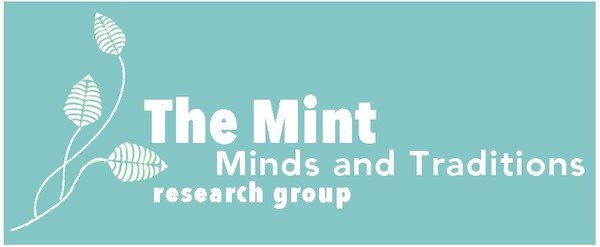
The Mint
The Minds & Traditions research group (aka "the Mint") is a Max Planck Independent Research Group opened in 2016. We explore the origins and evolution of graphic codes. All humans can communicate with sounds (or gestures) that encode information in a standardised way, using the same code in a wide variety of domains. Yet most humans in the course of our evolution had no similar use for permanent images: there was no all-purpose standard code for graphic communication. Many societies now use only ad hoc graphic codes, useful in a few contexts only. All-purpose graphic codes emerged only slowly and recently, at first for very small numbers of users.
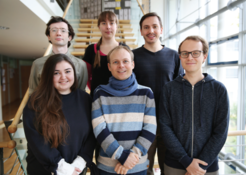
At the Mint, cognitive science, linguistic anthropology and quantitative cultural history gather forces to shed light on the evolution of graphic communication. We study visual culture and graphic communication in a broad sense that encompasses all graphic codes, from writing systems to mnemonic pictographs, heraldry, and coinage. We study them in a comparative and evolutionary perspective, combining the fruits of cultural history and anthropology with an experimental approach. Simulating the evolution of graphic codes in the lab allows us to test and generate hypotheses that feed exchanges between experimentalists, cultural historians, and anthropologists.
The Mint shares in the broad ambition of the Department of Linguistic and Cultural Evolution: we want to contribute to a new interdisciplinary culture that brings quantitative tools to the study of cultural change. While our methodological background is strongly influenced by experimental approaches, we take every opportunity to test our hypotheses outside the lab—to make them robust, replicable, and relevant. All studies run at the Mint, experimental or not, follow state-of-the-art good practices: systematic preregistration, open data, and open code.
RESEARCH PROJECTS
How letters got their shape
The visual appearance of most scripts fits basic constraints of the human visual system, thus facilitating the perception and processing of letters. For example, cardinals (horizontal and vertical lines), which our brains perceive more fluently than oblique lines, are also more numerous (Morin 2018). The idea that cultural inventions like writing need to adapt to basic cognitive constraints has currency among cognitive scientists and anthropologists, but the cultural evolution of this phenomenon is poorly known. The Mint investigates it using the quantitative tools that other teams apply to the evolution of languages, and combining them with methods and results coming from experimental psychology (Tykhostup & Kelly 2018, Morin 2018, Morin, Kelly & Winters 2019, Kelly 2019).
We know a great deal about what makes shapes easy or difficult for human vision to process. Complex shapes, with a high ratio of contour to surface, take more time to process and tend to have less appeal than simple ones. (Letters like O or C are simpler than W or Q in this sense.) Cardinal straight lines (horizontals and verticals, as in H or E) are processed more fluently than oblique ones (as in W or X). The scripts used by the writing systems of the world must weigh these demands of visual simplicity against the need to encode large quantities of information (which overly simple or uniform shapes cannot do). Finding an optimal balance between informativeness and simplicity is a difficult task, for which a gradual and protracted process of cultural evolution might be needed. We study the ways in which various literate cultures have solved this problem, and we ask whether the last three millennia have seen global improvements in this regard.
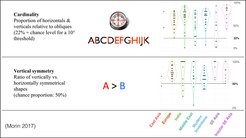
This research yields two kinds of results. First, we validate laboratory results for the first time outside the lab: we show that the psychophysical biases documented experimentally have real cultural consequences. For instance, Morin showed that the vast majority of the world’s scripts obeyed complex constraints related to the organisation of cardinal and oblique straight lines in letters. Second, we contribute to the budding field of cultural evolution by putting its hypotheses to the test: our work on the evolution of cardinal lines within letters addressed the question whether cognitively appealing cultural forms need a protracted evolutionary process to arise.
This research is part of a broader attempt to integrate the methods of cultural history with those of experimental psychology. Our ongoing work on the evolution of the Vai syllabary of Liberia exemplifies this. Of all the invented writing systems that appeared in colonial or post-colonial contexts in the last two centuries, the Vai script is one of the best documented (Tykhostup & Kelly 2018). Lead by Piers Kelly, an expert on contemporary invented scripts who has documented first hand the complex Eskaya writing system and its associated invented language (Kelly 2016), our Vai project started with the construction of a dataset documenting the shape of Vai letters in the various historical stages that the syllabary went through. The team then applied a variety of compression algorithms, verifying our prediction that Vai letters became simpler in the course of their 170-years evolution. A project lead by Helena Miton asks the same question on a larger scale. It compares the visual complexity of letters in more than 100 systems, using an expanded version of the database used in Morin (2018), which allows us to consider phylogenetic relationships between writing systems, and to test for evolutionary trends.
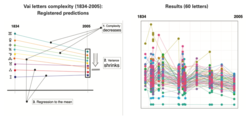
Evolving graphic codes in the lab
Experimental methods also help us explore the basic conditions that allow graphic codes to emerge (Winters, Kirby, & Smith 2018, Winters & Morin 2019, Pleyer, Hartmann, Winters, & Zlatev 2017). Humans are exceptionally good at inventing and learning communicative codes, especially spoken languages. But graphic codes emerged rarely in human evolution, in contrast to the universality of language. We hypothesise that this is due to the peculiar conditions of asynchronous communication, where a messenger imparts information to a recipient across time frames (Morin, Kelly & Winters 2019, Winters & Morin 2019). Synchronous (or face-to-face) communication is grounded in interactional mechanisms such as turn-taking or repair, as well as pragmatic factors like common ground. In contrast, messengers and senders engaged in asynchronous communication have little common ground to share, and no opportunities to repair misunderstandings.
To test this hypothesis, we ask experimental participants to design graphic codes in our lab, using the expertise brought from the field of language evolution by James Winters (whose PhD studies contextual effects on the experimental evolution of artificial languages), in conjunction with Thomas Müller, a doctoral candidate at the IMPRS, co-supervised by Morin and by FSU professor Stefan Schweinberger. We use “referential communication experiments”, adapted from classic work in experimental pragmatics to test our hypotheses. Participants can only interact with one another via black and white symbols. Their goal is to use these symbols to convey and distinguish between subtle shades of colours. One innovative aspect of our task is that participants do not receive direct feedback from the system about their performance. They can only use each other as guides, and can only guide each other by developing a graphic code from scratch. Studying the evolution of these dialects, we have assessed the impact of synchrony and asynchrony on the development of these codes. Our empirical results (one published study, two submitted), showcasing the crucial role played by shared contextual information in the rise of rich, informative codes, will be deepened using the data generated by the Color Game project.
The Color Game app
Laboratory experiments are limited in their demographic range (typically, a few Western undergraduates) and in the scale over which they unfold (two persons for a few hours). We want to move beyond these constraints by turning one of our referential communication games into a gaming app, the “Color Game” (Morin, Winters, Müller, Morisseau, Etter, & Greenhill 2018). It was released in April 2018 after two years of preparation with the game designers of Etter Studio, curators of the museum of Digital Arts in Zürich. Lead by Morin, Winters, and Müller, with the participation of Simon Greenhill of the DLCE, the project also benefitted from the help of Tiffany Morisseau, who later moved from her post-doctoral position at the Mint to an executive position at Strane, a leading French start-up incubator, as well as Ira Noveck, a leader in the field of experimental pragmatics. The advantages of a gaming app, compared to a traditional online experiment, have been underlined by several advocates of “smartphone psychology”, but so far very few concrete projects have followed upon these declarations. Subjects take part in online experiments at the experimenters’ request for a limited amount of time, reducing the quantity of data that can be collected, and leading to potential experimenter bias. In contrast, players choose to use gaming apps for their own enjoyment, on their own schedule, as often as they want. Like the participants in our referential communication experiments, the players of the “Color Game” organised black and white symbols into graphic codes that they used to communicate about colours. But unlike our Jena participants, the players could be from anywhere on the planet (the app is translated into seven languages and is to be made available worldwide). They could play as often as they want with whomever they want. The app’s sophisticated back-end interface guaranteed that players remain entirely anonymous, and could not contact their friends.
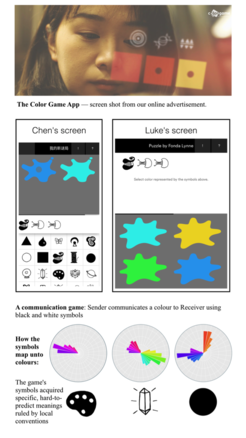
In the 11 months between its launch and its termination, the Color Game App was downloaded by more than 4000 persons, from more than 100 countries. Our final dataset records more than 300 000 interactions, between participants with varied cultural and linguistic backgrounds: the players’ mother tongues (more than 70 distinct languages) include Ingush, Bassa, Cebuano, and British Sign Language. The app saw the birth of a limited but genuine graphic language transcending linguistic and cultural boundaries, shared by hundreds of otherwise unrelated people. The scale of the dataset thus obtained allows us currently to test hypotheses that lab data cannot get at, because of low statistical power, or because laboratory settings cannot approximate the true scale of code evolution. The predictions being tested mostly attempt to understand how players managed to get the game’s symbols to carry information, in spite of their initial vagueness.
An online survey, independent of the App, shows that the symbols evoke some colours rather than others to untrained minds; but these prior associations are weaker than the ones fostered by regular communication through the app. Even inside the app, the same symbol can stand for strikingly different colours, depending on the convention that a given player has learnt to follow. One reason why communication does not break down in spite of this — is, in fact, surprisingly successful — could be what Nick Enfield calls the “Tolerable Friends” principle: words (and other symbols) may be used to transfer information between interlocutors even when their meaning varies drastically between interlocutors. The Color Game data also gives us the opportunity to test the computational models of language evolution being developed at the DLCE. With Simon Greenhill, we’ll investigate whether Bayesian inference algorithms are capable of reconstructing the network of players, using the “dialect” spoken by each player (the colours that each particular player assigns to each symbol).
Visual communication beyond writing
Understanding the evolution of writing requires us to explore other graphic codes that cannot be classified as writing: mnemonic codes, flags and other heraldic emblems, symbols found on coins, etc. These codes, classically known as semasiographies, do not encode components of spoken languages. They are also drastically limited, compared to writing, in the quantity and variety of information that they can encode. These limitations can teach us about the obstacles that blocked the development of writing systems in most cultures before Neolithic times. But their strengths tell us how far the human capacity for asynchronous communication may extend, in the absence of writing. The Mint’s research on this topic is a mix of data-driven and theory-driven approaches.

We compile state-of-the-art databases containing information on hundreds to thousands of artefacts, in open and standardised formats, in line with our department’s ambition to fashion and spread the best practices for linguistics and cultural data analytics. Olivier Morin and Helena Miton have built an extensive dataset of heraldic motifs (2018), while Barbara Pavlek, a student trained as an archaeologist and doing a PhD in cultural evolution at the Mint (jointly supervised by Morin and by FSU professor Annegret Plontke-Lüning) has produced a systematic synthesis of the extant datasets on ancient Greek coins. The Message Sticks database, coordinated by Piers Kelly and due to appear in 2020, studies the wooden tools that were used to assist in long-distance communication across Indigenous Australia. Their non-linguistic inscriptions were almost always accompanied by an oral message produced by the messenger, but to date the system underlying this unique graphic code has not been effectively reconstructed. This project is cooperating with the National Museum of Australia, the British Museum and a number of institutions in Europe to produce a database of artefacts and their meaning, and to answer questions about the limitations and opportunities of non-linguistic codes in comparative perspective.
Large, standardised datasets allow us to use information theoretic-tools to measure the capacity of two graphic codes, heraldic emblems and ancient coinage, to contain and impart information. Standard entropy measurements can be applied to the organisation of components inside a graphic symbol, telling us, for instance, to what extent the colours and figures that make up coats of arms occur in a non-random fashion (Morin & Miton 2018), or how predictable the occurrence of symbols on a coin can be. Information theory’s entropy measurements can also be applied to the relations between a symbol and its referent: whether coats of arms provide sufficient cues to identify their owners, or how much information ancient coin designs yield about the coins’ denominations. Our work on ancient Greek coinage, lead by Pavlek, shows a substantial increase in the informational value of coin designs between the birth of coinage and the dawn of the Hellenistic age. Applied to contemporary coins, the same methods reveal that coin designs tend to be more informative about high-value coins, and reflect monetary values on a logarithmic scale, not a linear one. We have applied similar tools to online visual cultures — on the Color Game project’s data, but also in our analysis of the evolution, complexification, and compression of the images created by the one million users of the Reddit “Place” project (Müller & Winters 2018).
Cultural evolution at large
The Mint’s activities are not limited to graphic codes. We also contribute to the study of linguistic and cultural evolution in the broadest sense. We regularly intervene in theoretical debates elicited by the growth of cultural-evolutionary models (Morin 2016, Morin 2019, Viciana, Cova, Baumard, & Morin 2018) and in “digital humanities” research applying quantitative tools to historical changes in literary forms (Morin & Acerbi 2017, Moretti & Sobchuk 2019, Morin, Acerbi, & Sobchuk 2019). The Mint’s projects in this area are lead by Morin and Oleg Sobchuk, who did his PhD with Stanford University’s leading centre for digital humanities. One of our favourite tools to study literary works is lexiconomics, or word count studies, which reveal surprising, long-standing trends in literary evolution—such as the gradual and steady erosion of emotional terms in European literature (Morin & Acerbi 2017). Our paper on this topic shows that the strong decline in emotional expression in 19th and 20th century literature was driven by a collapse of positive emotions. From a methodological point of view, it argues that quantitative cultural history benefits from combining results from big-data corpus such as Google Ngram with smaller and better-understood corpora. Such studies may in the future allow us to build bridges between computational linguistics and digital humanities, in Jena and elsewhere. In the same spirit, we are starting, this year, a new project involving a student from the first cohort of the institute’s IMPRS doctoral school, Ayaka Tsuchiya, who will study possible links between the evolution of the human linguistic capacity and the evolution of music, in collaboration with FSU’s Stefan Schweinberger.
Going beyond the study of graphic codes allows us to build bridges between linguistics and cultural evolution, one of this institute’s main research goals. While trying to develop cross-disciplinary fields that see themselves as working on the cutting edge of research, we are careful also to heed the lessons of more traditional approaches to the study of culture. Our work on the evolution of writing systems contributes to an important ethnographic literature, based on the observation of de novo inventions of literacy in small-scale societies (Morin & Déléage 2018, Kelly 2018, Kelly 2019). One topic that looms large in discussions between mainstream anthropology or linguistics and cultural evolution concerns the relations between psychology and culture, and in particular the mechanisms at play in cultural transmission, a question we have done much to address (Mascaro, Morin, & Sperber 2017, Mercier & Morin 2019, Morin 2018, Morin 2019). By maintaining dialogues between all the branches of the humanities concerned with non-verbal communication, and opening up new lines of enquiry to catch the interest of cultural evolutionists, we hope to renew and unify the study of graphic codes and cultural transmission.




